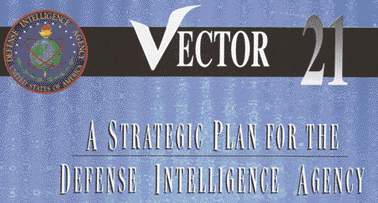


Vector 21 is a strategic plan for the Defense Intelligence Agency. This plan reflects our vision, mission, values, organization and goals. Vector 21 embodies the direction and guidance of the National Military Strategy and Joint Vision 2010.
Comments should be directed to the Plans, Programs and Operations Staff (PO), Defense Intelligence Agency, Washington, DC 20340.

Defense Intelligence is confronted with a variety of new conditions and circumstances as the 21st century approaches. These challenges are marked by an historic reordering of international relationships, a process that is unlikely to stabilize soon; an unprecedented explosion of technology, carrying with it the potential to alter rad-ically personal and institutional relation-ships and to change the nature and conduct of warfare; and, persistent glo-bal and transnational problems, some of which seem solvable and others that seem very difficult to solve. These challenges will compel the Defense Intelligence Agency (DIA) and U.S. Mili-tary Intelligence to perform our combat support mission in ways that, in many cases, will be revolutionary.
These circumstances confront not only the Defense Intelligence Agency, but senior policymakers and military commanders. Their concerns and responses dictate our own. Already, this decade has seen an increase in the frequency of limited employment of our military forces, unilat-erally and in temporary, multinational coalitions, for operations other than war. These operations focused principally on humanitarian assistance, peacekeeping, and deterrence, require an in-depth understanding of the threat and the operational environment. The fact of a smaller military force, coupled with rapid advances in weaponry and related technology, has, in part, caused defense plan-ners to shift emphasis to joint operations, precision weapons, and information dom-inance as the hallmarks of our fighting force. Our national security policy of engagement and enlargement has caused us to redouble our efforts to solve global problems, such as proliferation of weap-ons of mass destruction, international ter-rorism, international narcotics trafficking, organized crime, and threats to our infor-mation infrastructure and related systems.
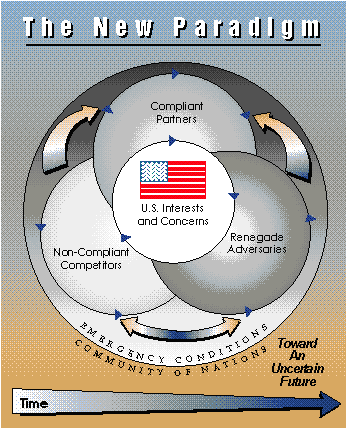
These global challenges and our nation�s responses provide insight into what the focus of Defense Intelligence will be at the beginning of the 21st century: regional orientation, the application of sophisticated technology and a rapidly adaptive approach to all aspects of developing policy and conducting military operations. In support of these goals, the DIA, a Department of Defense Combat Support Agency and member of the United States Intelligence Community, has a plan, to guide our future. That plan is Vector 21.
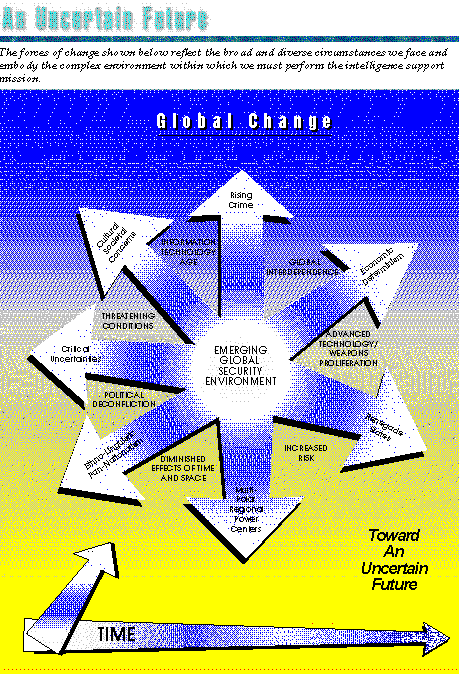
In answering the call to public service, mindful that Defense Intelligence belongs to the Ameri-can people and that we must keep their trust by serving their interests, conserving their resources, and responding appropriately to elected representatives and appointed authori-ties in accordance with our constitu-tional oath. In providing the finest, on-time intelligence to American warfighters and peacekeepers, to Defense planners, and to the leaders whose daily decisions affect the fate of our nation.
In executing our mission, approaching every task with dedication and strength of purpose, knowing that American lives and the well-being of the nation depend on it being done right. In actively engaging our consumers, anticipating their requirements, meeting their changing needs, and unfailingly delivering quality products anywhere, anytime. In ensuring the absolute integrity of our intelligence products and services, and in abiding by the highest ethical standards of personal and professional conduct.
In demonstrating sound management and leadership, based on principles of empowerment and inclusion; open, hon-est, effective communications; team-building; coordination; corporate decisionmaking; and the full profes-sional development of each and every member of our organization.
In maximizing our individual and collective potential, by encouraging creativity, initiative, and the free exchange of ideas; by taking personal responsibility for exploiting all available professional growth and development opportunities and by promoting collegiality and co-operation � with the aim always of improving the quality of everything we do as individuals, as team members, and as a Combat Support Agency.
In fostering harmony in our professional relations, creating an atmosphere that promotes fairness and openness in all per-sonnel practices, nurtures self-esteem and individual worth, and respects human cultural diversity and the rights of others.
In remembering to balance the demands of our mission with personal, family and community responsibilities. In promoting teamwork as a way of life, mission accomplishment as a shared responsibility and individual and organizational commitment for the greater good.
In leading innovative change in the nature and conduct of intelligence activities by anticipating, envisioning, and adopting concepts, doctrine, strat-egies, technologies, and processes that undergird full-spectrum dominance.
In providing total commitment to the betterment of Defense Intelligence and the U.S. Intelligence Community and ultimately to the security of the United States of America.

The Defense Intelligence architecture provides the overall structure for intelligence support. While not strictly hierarchical, formal relationships exist among the national, theater, and task force intelligence organizations and elements. These relationships facilitate requirements management and optimize complementary intelligence functions by echelon without obstructing the timely flow of intelligence to an information grid connecting all echelons. The national intelligence agencies maintain systems and organizations that respond directly, and provide intelligence, to any echelon for time-sensitive support.

During a crisis, the formal flow for intel-ligence requirements from all echelons in support of joint operations is through the National Military Joint Intelligence Center (NMJIC) � the focal point for all Defense Intelligence crisis operations and activities. The Unified Commands� Joint Intelligence Centers (JICs) and Joint Intelligence Support Elements (JISEs), subordinate to Joint Task Forces (JTFs), are the principal organizations that support joint warfighting at the operational and tactical levels. All JICs perform common functions, while the JISEs are tailored for the specific mis-sions of the JTF. The JIC concept fuses the main intelligence support capabili-ties of the military services, the Combat Support Agencies, and combat units into a one-stop shopping center for intelligence support. A particular JIC cannot be expected to satisfy every intelligence requirement completely; however, it can coordinate support from other intelligence organizations above and below its echelon. Because the JIC is the focal point for intelligence operations, the JIC may draw upon additional resources (including military reserves) in coordination with the Joint Staff, DIA and the military services. A subordinate joint force, when estab-lished, forms a JISE as a tailored subset of the theater JIC. JISEs are established to meet the particular needs of subordi-nate joint forces and therefore do not replicate every facet of JIC operations.
The JIC and JISE, by design, can expand to meet the needs of the Joint Forces Commander (JFC). During non-crisis periods, JIC manning normally is retained at the minimum level required to perform essential functions, such as Indications and Warning (I&W), current intelligence, collection management, general military intelligence production, support to the commander and support to the intelligence readiness of theater forces. As crises develop, JICs at each echelon focus the personnel and equip-ment needed to manage intelligence support requirements. Collection, pro-duction, and dissemination resources are applied to the crisis and in support of theater operations orders, plans, and joint tasking. Liaison with intelligence production agencies and communica-tions staffs identifies critical shortfalls, and corrective actions are taken.
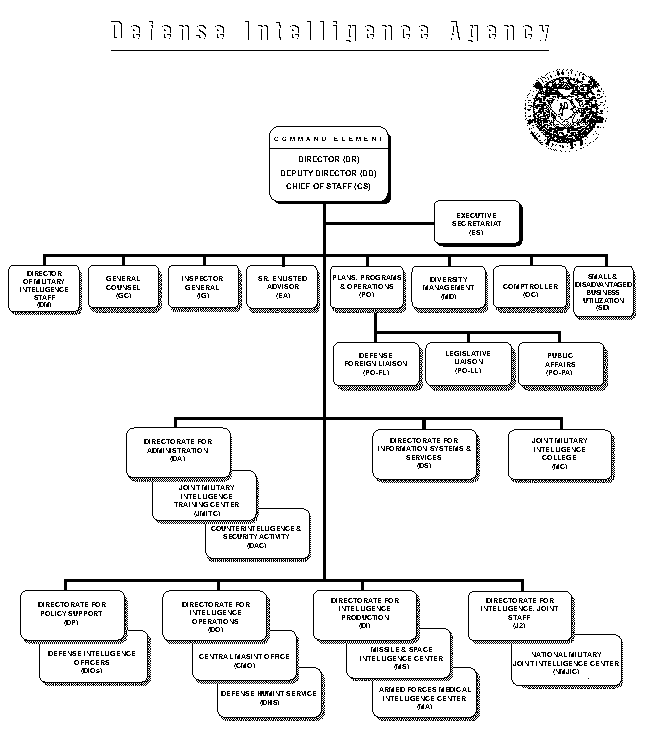
At the national level, to meet the needs of the warfighter, decisionmaker, and policymaker, the Defense Intelligence Agency is organized along major func-tional lines of collection operations, analysis and production, dissemination systems, services, and policy and admin-istrative support. The Agency is led by a three-star general or flag officer with a senior civilian executive as deputy. The Chief of Staff is a senior civilian execu-tive who oversees the operations of the staff of the headquarters element.
The headquarters or command element of DIA consists of several staffs and offices. For the Director�s Defense Intel-ligence Community responsibilities, the Director, Military Intelligence Staff (DM), provides plans, policies, and pro-grams to manage the resources that support the Defense Intelligence Agency, Services, and Unified Commands. This management or coordination of pro-grams includes the General Defense Intelligence Program (GDIP) and part of the Joint Military Intelligence Program (JMIP). DM also provides support to the Military Intelligence Board (MIB) and manages the Reserve forces assigned to Defense Intelligence. The Plans, Programs, and Operations Staff (PO) is responsible for internal planning and programming, liaison with Congress, the press and the public, and foreign attaches.
The Command Element�s immediate support staff is the Executive Secretariat (ES). ES provides administrative, staff and service support to the Command Element; facilitates effective communications/sup-port links between and among the Command Element and all subordinate line and staff elements; and maintains and manages the Agency-wide Automated Tasking System.The Command Element also contains key offices for legal, fiscal, and oversight responsibilities as a Federal Agency. The Office of the General Counsel provides the Director and all Agency personnel advice on the application of law to Defense Intel-ligence Agency operations. The Inspector General�s office was established by the Director as an independent office within the DIA for internal audit, inspection, and investigation. The Comptroller exercises the Director�s authority and responsibility for planning, organizing, directing, and implementing an integrated program for financial management, budgeting, and force structure management. The Director maintains an office for Diversity Management (MD). This office provides overall responsibility for development and implementation of DIA civilian and military diversity management policies, procedures, and programs. The Senior Enlisted Advisor and the Small and Disadvantaged Business Office advise the Director on spe-cific issues.
DIA�s intelligence analysis and production capabilities are located in three directorates. The Directorate for Intelligence (J2) serves the Chairman of the Joint Chiefs of Staff, Secretary of Defense, Joint Staff, and Unified Commands as the national focal point for crisis intelligence support to military operations and DoD indications and warning (I&W). The J2 also coordinates joint intelligence doctrine and architecture, and serves as the Director of the Joint Requirements Oversight Council�s Intelligence, Surveillance and Recon-naissance Joint Warfighting Capabilities Assessment. As components of the National Military Joint Intelligence Center (NMJIC), J2�s alert center provides real-time I&W assessments and targeting support to key decisionmakers, while the Defense Intelligence Network globally disseminates timely and accurate all-source crisis intelligence via multi-media formats.
Under the Directorate for Intelligence Production (DI), the Operational Intelli-gence Crisis Center (OICC) manages crisis- related military intelligence production, including joint intelligence preparation of the battlespace. DI also produces or manages the production of all-source military intelligence to sup-port the operational, planning, and pol-icy requirements of the U.S. armed forces, as well as the Services, the Uni-fied Commands, DoD policymakers, and national-level agencies. As the DoD Production Functional Manager, DI ensures that DoD intelligence production requirements are articulated and resources are programmed and executed in consonance with Defense and national guidance. Production programs are also re-evaluated as missions, technical capabilities, and threat envi-ronments change. DI�s analytic expertise includes military capabilities, scientific and technical, missile, medical, estimative, military production and geography, intelligence databases, and operational support and targeting intel-ligence for tactical, theater, and national consumers.
To address the needs of the Office of the Secretary of Defense (OSD) and other national-level policymakers, the Directorate for Policy Support (DP) provides direct intelligence support through DIA�s senior analysts, the Defense Intel-ligence Officers (DIOs), as well as man-aging special access programs. Additionally, DP provides assistance with foreign disclosure and agreements.
The Directorate for Operations is respon-sible for the centralized management of DoD all-source intelligence collection. These responsibilities include directing and managing DoD-wide intelligence collection requirements in support of national and theater consumers and the centralized direction and management of the DoD HUMINT Service (DHS), including operation of the Defense Atta-che System (DAS).
DIA, through the Directorate of Operations, also serves as the Director of Cen-tral Intelligence (DCI) Executive Agent for Measurement and Signatures Intelli-gence (MASINT) and the DoD MASINT collection manager. The Central MAS-INT Office (CMO) carries out this responsibility.
For the management of DIA�s informa-tion technology and services, the Direc-torate for Information Systems and Services (DS) performs several key func-tions. Specifically, DS provides auto-mated data processing engineering, development and operations support, information and library services, hard-copy and electronic publication and dis-semination, imagery processing, storage and retrieval, and video and visual information services. DS also is the lead for the Department of Defense Intelli-gence Information System (DODIIS) Management Board (DMB), which func-tions as the board of directors for the DODIIS Community, providing engi-neering support, systems integration, and life-cycle management support.
The Directorate for Administration (DA) provides a wide range of services, training, and support to both DIA and external customers in the continental United States and overseas. The Direc-torate establishes policies, implements programs and procedures, and pro-vides Agency-wide administrative oversight with respect to the Agency�s security, military and civilian human resources, training and career development, logistic services and facilities management, procurement and contracting, and records management. DA also contains the Counterintelligence and Security Activity, which serves as the focal point for issues on counterintelligence and for assessments of the threat posed by foreign intelligence activities. The Activity provides counterintelligence (CI) staff support to the Chairman, Joint Chiefs of Staff and the combatant commands. Other functions include the DoD CI collection require-ments manager; CI staff support to the DoD HUMINT Manager; the conduct of all-source CI analysis of foreign intelligence activity; the production of CI assessments, studies, estimates, and finished products; and the coordination of the CI production programs of all DoD CI components.
The Joint Military Intelligence College (MC) is a unique joint service intelli-gence educational institution autho-rized by Congress to award an accredited Master of Science of Strategic Intelligence degree. It prepares military and federal civilian professionals from throughout the Intelligence Community to satisfy intelligence requirements as full partners in safeguarding and advancing the nation�s interests. The College also conducts and disseminates relevant intelligence research.
DIA�s continued successes are due, in part, to the outstanding education and training afforded all members of Defense Intelligence. Resident within DIA, the Joint Military Intelligence College sees to the education of intelligence profession-als who will be called upon to provide foreign military and military-related intelligence as part of military operations in peacetime, crisis, and combat; force planning and weapons system acquisi-tion; and defense policymaking. Offering personnel from each of the Services and the Intelligence Community a high-qual-ity professional and fully accredited academic education at the graduate and undergraduate levels, the College pre-pares them for senior command, staff, and policymaking positions throughout the Intelligence Community. The premier professional development opportunity for DIA�s personnel is the JMIC�s Post-Graduate Intelligence Program, which offers the Master of Science of Strategic Intelligence (MSSI) degree, the only such degree available anywhere in the country. For training, the Joint Military Intelli-gence Training Center (JMITC) within the Directorate for Administration manages the General Intelligence Training System for the Department of Defense. The JMITC ensures that the necessary training for all Defense Intelligence is provided in a timely, efficient manner any time or place there is a demand. Training is pro-vided in management, analysis, collection management, and automated systems as well as basic skills training for all posi-tions within the Defense Intelligence Agency.
The Defense Intelligence architecture includes an information and communica-tions network known as JWICS (Joint Worldwide Intelligence Communica-tions System) with interoperable systems that interconnect the most vital compo-nent, the people, who are the collectors, producers, and consumers. It provides the means to link the theater Joint Intelli-gence Centers, Joint Task Force Joint Intelligence Support Elements, deployed intelligence elements, Service intelli-gence, and national intelligence organiza-tions in a global grid. All intelligence made available to the network is commu-nicated to users throughout the system. The data are stored and accessed on a DoD standards-compliant automated system that interfaces with the communi-cations network.
To provide tailored intelligence support to the Joint Force Commander, the NMJIC can deploy a National Intelligence Support Team (NIST) for support during a crisis or operation. A NIST will be com-posed of representatives from DIA, NSA, CIA, and any other intelligence organiza-tion requested by the Unified Com-mander. A NIST deploys with its own intelligence support capability, using the joint force�s existing communications sys-tems. A NIST, acting as a liaison element, provides key on-site support to the joint force J2 to ensure the receipt of national intelligence.
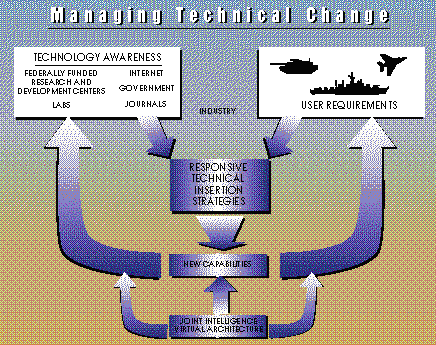
The Defense Intelligence architecture is a dynamic, flexible structure providing glo-bal access to an information grid that con-sists of all intelligence sources at all echelons. The architecture facilitates the capability of the Military Intelligence Community to focus on supporting the Joint Force Commander and subordinate components, and to integrate support from non-Defense agencies and non-gov-ernmental organizations, as required. The Defense Intelligence architecture is config-ured to provide access to all intelligence sources from anywhere on the globe and to provide essential data that the Joint Forces Commanders will need to support their joint operations. Integrated System
The Defense Intelligence architecture is a network of integrated workstations, file servers, and communications links. These elements must work together, consistent with common DoD standards, to create the interoperable information environment required to support mili-tary operations, defense planners, and policymakers. The network includes direct connectivity by communications links and broadcast capability to support time-sensitive needs. The Military Intelligence Community has established an information grid that allows data collected by various means to be communicated directly to a user, processing site, or collection platform by the most efficient path. An important aspect of the information grid is its ability to make all intelligence, including direct collector-to- user information, accessible via stan-dardized file servers to standards-compliant work stations.

To maximize the utility of the architec-ture, all systems must meet standards of connectivity using DoD standard com-munications protocols and standard security devices available at all echelons. The Joint Worldwide Intelligence Communications System (JWICS) and Joint Deployable Intelligence Support System (JDISS) are the standard and foundation for commonality among support sys-tems. The JWICS satisfies the requirements for secure, high-speed, multimedia transmission services for intelligence information down to the JIC level. JWICS incorporates advanced net-working technologies that permit theater throughput and capacity, making possible the use of applications that take advantage of multimedia technologies, including video teleconferencing. The JDISS, a transportable automation work-station, works with existing communica-tions to electronically extend a JIC to a JTF or to other subordinate forces.
All-source intelligence dissemination employs a variety of means to deliver high-quality, relevant intelligence to con-sumers. In support of joint operations at the national, theater, and subordinate joint force levels, dissemination will be via JWICS and JDISS. These systems sup-port the production, dissemination, and display of fused intelligence critical to theater battle management. The Joint Intelligence Architecture provides access to data from national, theater, and tactical intelligence organizations and sources primarily from a �brilliant push-smart pull� system. The �smart pull� refers to the consumer�s ability to query or select from intelligence databases relevant intel-ligence based on their mission and need for information. The �smart pull� capa-bility is designed to prevent communica-tions circuit saturation while permitting multiple users access to important infor-mation. Additionally, intelligence will be �brilliant pushed� to selected consumers in response to established requirements and essential elements of information. The up-, down-, and across-echelon inter-face among strategic, operational, and tactical intelligence organizations is the backbone for Defense Intelligence dissemination.
Our objective for the future system is to provide the Defense Intelligence Community�s analytical workforce the cognitive tools and automated capabilities necessary to ensure successful mission accomplishment in tomorrow�s high optempo, information-rich environment. This future architecture will ensure transparent, virtual, and seamless electronic connectivity from national, theater, or tactical levels in support of both decisionmakers and warfighters. The objective is to better enable the intelligence consumer to under-stand the environment and synthesize rele-vant facts from a complex information domain. For the Intelligence Community, the goal is to significantly accelerate and make the intelligence cycle more meaningful.
Advanced knowledge-based tools will target areas of information visualization, presentation, analysis, multisource information fusion, information management, and terminus delivery techniques. Coupled with ubiquitous, high-capacity communications, advanced tools will facilitate real-time predictive analysis and virtual collaboration with multiple users. This evolution will eliminate the physical limitations posed by location, classification levels, and mobility requirements, while using the capabilities of a more capable world-class analytic and associated support workforce. The Joint Intelligence Virtual Architecture (JIVA) will also provide the foundation for future tech-nology and very advanced applications. The following illustrates subcomponents key to the architecture of the future system.
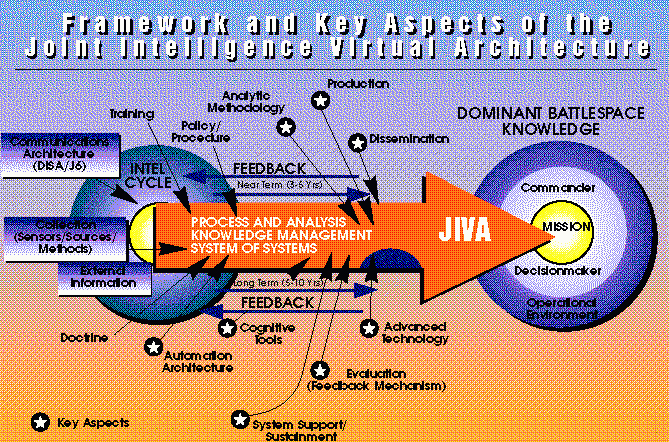
People: Skilled, Trained, Committed
DIA is firmly committed to utilizing its most valuable asset, its people, by developing and maintaining a diverse, well-trained cadre with the talent, energy, and vision necessary to meet the challenges of our dynamic support requirements in the future. Our ana-lysts, collectors, and information tech-nologists can perform all-source fusion of complex information using knowl-edge- based tools. They are people who possess solid knowledge and under-standing of the military art, science, and operations of U.S. and key foreign forces. They are also people with expert technical knowledge, including an understanding of automated data pro-cessing and telecommunications required to collect, process, produce, and disseminate intelligence to users and consumers. New talent will be gained by recruiting, developing, train-ing and retraining the highest quality analysts. Senior specialists will be developed from within the Agency by providing rewarding and well defined career paths from the entry level to the most senior technical, analytical, and managerial levels. By demanding pro-fessional certification, offering profes-sional development opportunities in all intelligence fields and throughout the intelligence community, providing currency- training, sponsoring active men-torship programs, and promoting cross-training and rotational assignments, we will achieve and maintain this future cadre.
Information Integration
DIA will maintain an open systems archi-tecture that will allow the rapid integration of knowledge-based tools and that will achieve the blending of discrete activities of the intelligence cycle into a homo-genous Defense Intelligence infosphere. JIVA will help to create a collaborative electronic workspace for information technologists to eliminate the physical limitations imposed by location, classification level, and mobility requirements. DIA is committed to the DoD Common Operating Environment, the Global Command and Control System, and the Global Broadcast System to facilitate the transfer of the intelligence we produce.
Technology Insertion
The Agency will recapitalize its technol-ogy in leading-edge information and communications capabilities by carefully managing technological change. This requires an awareness of technological developments, users� requirements, fiscal restraints, and technological insertion strategies that translate into new techni-cal capabilities. The Agency, in the con-text of JIVA and other DIA and community initiatives, will actively support the standards and open systems goals of the Intelligence Community, the Defense Information Infrastructure, and national commercial best practices to ensure compatibility and interoperability with all customers. Successful technology insertion requires a proactive customer requirements awareness and manage-ment process to anticipate new mission needs that will drive applications for new technology. A revolving, rapid recapital-ization based on a periodic cycle (3-5 years) is required to stay ahead of tech-nology obsolescence.
Systems Security
The Agency has implemented a technical risk-management rather than a risk-avoidance policy that guarantees the security, integrity, and availability of national intel-ligence assets and capabilities. This policy will evolve to a multiple-level security sys-tem in which appropriate information can be accessed from a single workstation via a single physical communications net-work. Information dominance will be the pivotal cog, for the virtual architecture and for technical risk management. The physical environment will feature advanced security technologies, such as biometrics, high- speed data encryption cards, and data labeling.
Advanced Knowledge-Based Tools
Practical virtual integration of the intelli-gence cycle will occur when the Agency�s professionals have sophisticated informa-tion and communication tools to enable a significantly accelerated intelligence cycle, providing early, predictive intelligence and accurate estimates. Knowledge-based tools are the keystones for this effort.
They will allow the analysts to achieve rapid bat-tlespace awareness and comprehension and contribute to the military operators� achievement of battlespace dominance.

Emphasize the users� needs through modern-ization and continuous improvement of our collection operations, analysis and produc-tion, and dissemination to allow military operators, policymakers, and decisionmakers to attain and maintain dominant battlespace knowledge in their operating environment. We will continually evaluate and re-evaluate our processes in the intelligence cycle to ensure currency and relevance in a rapidly changing world.
1.1 Mission
Lead Defense Intelligence in fulfilling our mission of intelligence support to the war-fighter, decisionmaker, and policymaker.
Goal: Strengthen the Military Intelli-gence Board process and use this forum to engage in the corporate business of Defense Intelligence.
Goal: Exploit advanced technology to collect, process, and analyze informa-tion and to disseminate needed intelli-gence worldwide.Goal: Conduct a review of operational plans to identify personnel, equipment, and systems apportionment require-ments and shortfalls.
Goal: Associate and integrate with NIMA, CIA, NSA, INR, FBI, and other intelligence community elements to ensure the best possible military intelligence support.
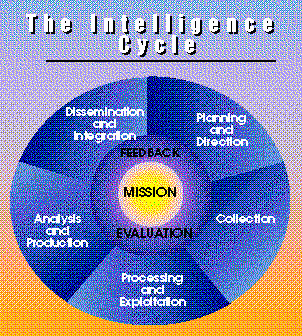
1.2 Planning and Direction
Steer corporate planning, programming, and management of Military Intelligence resources more efficiently and effectively in peace, crisis, and conflict.
Goal: Create flexible procurement, replacement, and insertion strategies that will keep pace with technological change and innovation.
Goal: Plan and develop an interactive, interoperable fully automated personnel data base that responds to demographic, mission, and skills-based queries on per-sonnel and is compatible with the Intelli-gence Community�s needs.
Goal: Identify the appropriate future com-position of Military Intelligence Service personnel within the Unified Commands.
Goal: Identify current and potential future work force shortfalls based on changes in the Unified Command Plan, expanded missions and requirements, and systems/technology.
Goal: Provide intelligence resources at all Joint Reserve Intelligence Connectivity Program sites to ensure Reserve compo-nents are effectively integrated into the active infrastructure.
Goal: Strengthen and streamline Military Intelligence Board processes to expedite decisionmaking on key intelligence issues.
Goal: Implement and sustain a total quality program that will build a work environ-ment where ideas and innovation are encouraged and efficiency and effective-ness of Agency operations are improved.Goal: Actively pursue a Business Pro-cess Reengineering Program to redesign processes and organizations to achieve improvements in providing military intelligence to consumers.
1.3 Collection
Ensure the timely and prioritized �brilliant� coordination and tasking of national collection systems. Complement the management of col-lection requirements with the coordination of collection operations. Continually monitor the results of national systems tasking to ensure that subordinate organizations receive the proper priority for their requests and timely responses to their intelligence requirements. Pursue nontraditional sources of information and intelligence.
Goal: Support warfighter and DoD require-ments at the national level for collection, to include evaluation of requirements that are submitted and recommendations for alter-native collection means.
Goal: Enhance Defense HUMINT Ser-vice (DHS) collection capabilities by focusing DHS field collection on war-fighter and DoD requirements; improve DHS internal capabilities and processes; expand joint capabilities and operations.
Goal: Operationalize MASINT support to the warfighter by establishing and sustaining the U.S. MASINT System, supporting consumers during peace, natural disaster, crisis, or war, and devel-oping appropriate resource and technol-ogy solutions.
1.4 Processing and Exploitation
Anticipate requirements and respond with the best intelligence service support in the world. The standard measure is to ensure delivery of any intelligence product to the warfighter, analyst, or decisionmaker within two hours.
Goal: Standardize products, processes, and formats as required to allow seam-less transfer to facilitate the intelligence process and to support analysts, policy-makers, and warfighters.
Goal: Provide all products and databases online and in alternate media, where possible, to meet the requirements of 21st century battlespace dominance.
Goal: Improve customer service to ensure a responsive, quality-oriented organization.
1.5 Analysis and Production
Lead as the focal point for fused, national all-source military intelligence, including indications and warning, current, general military, scientific and technical, and targeting intelligence analysis, production, and reporting and coordinating national- and Service-level intelligence resources.
Goal: Establish an Intelligence Analyst Development Program that provides entry-, mid-, and senior-level training and education to prepare military analysts for the defense issues of the 21st century.Goal: Produce timely, accurate, and relevant intelligence that anticipates and responds to the deliberate and crisis plan-ing process of military operators, planners and policymakers.
Goal: Surge analytic efforts to provide immediate, focused 24-hour support to deployed forces and detailed analysis to support targeting and other planning needs.
Goal: Develop validated futures-threat intelligence tailored to the needs of force modernization programs and policy requirements designed, in part, to avoid technological and operational surprise on the battlefield.
Goal: Develop and maintain detailed, online, interactive, inter-relational intelli-gence knowledge bases specifically correlated to the functional, operational, and concept plans tasked by the JCS Joint Strategic Capabilities Plan.
Goal: Create a modernized intelligence operating environment for the 21st century.
Goal: Integrate diverse systems and pro-grams hardware and software purchases to build a virtual analysis and production capability from the national, to the Joint Task Force, to the military component in any theater, including key allies and potential coalition partners.
Goal: Facilitate and coordinate production of intelligence by multiple, physically sep-arate organizations collaborating in a dynamic real-time environment.
Goal: Develop a �virtual� DIA crisis center connected electronically to the JTF and its engaged components, NMJIC, OICC, military intelligence analytic organiza-tions, and others to use all crisis-relevant analytic expertise throughout the Defense Intelligence Community
Goal: Integrate and leverage production and analysis from non-traditional sources such as academia, research insti-tutions, and labs.
Goal: Establish a focused and clearly defined analytic career development program to posture military intelligence analysts for the future.
1.6 Dissemination and Integration
Lead the Defense Community in publishing softcopy, hardcopy and mixed media, including graphical and audio-video intelligence reporting. Disseminate these data through multimedia formats worldwide; maintain extensive archives; ensure this information is accessible to the warfighter and responds to the warfighter�s needs.
Goal: Implement a dissemination archi-tecture that integrates hardcopy and softcopy intelligence products for world-wide dissemination to U.S., Allied and coalition military forces.
Goal: Develop an overarching migration and data standardization strategy for managing intelligence across the military services, Unified Commands, and Defense agencies.
Goal: Steer the development of intelli-gence systems to comply with Defense Information Infrastructure and Common Operating Environment Standards.
Goal: Acquire the right systems and architecture to achieve our vision of on-demand intelligence products.
Goal: Ensure the timely delivery of intelli-gence to the lowest operating level that requires the information.
1.7 Feedback and Evaluation
Constantly review and assess our processes to ensure we are meeting the needs of the consumers of intelligence.
Goal: Evaluate the General Intelligence Training System to ensure that military and civilian intelligence training is con-sistent with knowledge, skills, and abili-ties necessary to meet the challenges of the 21st century.
Goal: Assess the output of the collective analytical process to ensure consonance with the Defense Planning Guidance, the Joint Strategic Capabilities Plan, and related implementing documents.
Goal: Conduct periodic Intelligence Pre-paredness Assessment reviews to ensure correlation and relevance of intelligence production to the deliberate planning process and objectives.
Goal: Do what is necessary to ensure that we are meeting the needs of the users and consumers we support.
Attract, recruit, train, educate, and retain the highest caliber workforce, while emphasizing personal and professional development for military and civilian members of the Defense Intelligence Agency team.
The men and women of the Defense Intelli-gence Agency are our most important asset. We will ensure that all personnel, military and civilian, active duty and reserve, are provided the opportunity to fulfill their potential. Our Vision Force 2010 demands that we recruit and train only the most highly skilled and experi-enced people willing to accept the challenge of the Defense Intelligence Agency�s mission.
Goal: In concert with the recommenda-tions of Vision Force 2010, recapitalize and rejuvenate the intellectual base of the workforce by developing a recruit-ment plan for individuals with the unique range of skills and expertise required to support modern warfare.
Goal: Educate future leaders of the Intel-ligence and National Security Commu-nities so they can anticipate and tailor the intelligence required at the national, theater and tactical levels.
Goal: Continue emphasizing the recruit-ment and career development of diverse, multicultural personnel who represent the population of our country.
Goal: Create and sustain a unified Defense Intelligence civilian personnel system and a supporting, complemen-tary career development and training system.
Goal: For uniformed military intelli-gence professionals, develop and institutionalize standards and programs for Joint Military Intelligence Officer and Noncommissioned Officer specialties.
Goal: Develop quality-of-life initiatives that capitalize on the diversity of our people, making the Defense Intelligence Agency the employer of choice.
Goal: Develop and implement an employee retraining and reassignment program that emphasizes developing key future skills in priority mission areas, building on the findings in Vision Force 2010.
Capitalize on future technological innova-tion to develop synergistic intelligence systems for the 21st century.
The Defense Intelligence Agency�s vision for the 21st century is highly systems-centered. Advances in sensor, information processing, and communications technologies will lead to capabilities that will enable the United States to achieve and maintain information dominance. All media, whether voice, data, graphics, maps, or video, will be available to Defense Intelligence users at every level. Automated data processing and telecommunications systems are resource multipliers, providing the Intelligence Community the ability to connect reliably, directly and instantly, to knowledge, resources and capa-bilities, at all levels, in support of the warfighter, decisionmaker, and policymaker.
Goal: Recapitalize systems using leading-edge automated information processing, analysis, and dissemination technologies to meet the needs of the 21st century warfighter.
Goal: Working through the Joint Require-ments Oversight Council process, develop innovative technical solutions and systems that have the flexibility, global reach, and capability to meet the needs of military users and policymakers in support of oper-ational requirements in the 21st century.
Goal: Develop and implement a life-cycle plan for managing and upgrading the joint intelligence architecture.
Goal: Examine technologies to facilitate linking into the Defense Intelligence architecture national-level intelligence agencies; selected U.S. and Allied corporate leaders and academia; and Allied active and reserve intelligence organizations, to capitalize on their relevant skills and experience.
We will invest in the future by recapitalizing our existing facilities. DIA will take advantage of initiatives in construction technologies, energy conservation, environmental protec-tion, and information systems to maintain, repair, alter, build, and occupy facility space in the most efficient manner consistent with superlative mission support. We will empha-size work environments that not only meet the basic needs of the occupant, but also enhance performance and multiply output.
Goal: Revise or institute procedures and policies to ensure our people, informa-tion, facilities, and operational capabili-ties are protected from harm.
Goal: Recapitalize the facilities of the Missile and Space Intelligence Center to consolidate all functions at one location and to provide state-of-the-art work areas.
Goal: Consolidate widely dispersed operations in the National Capital Region by completing the Defense Intel-ligence Analysis Center at Bolling Air Force Base through the construction of additional modules coincident with or adjacent to the existing building.
Goal: Ensure that the recapitalization of the Pentagon meets the needs of DIA and corrects existing safety and health deficiencies.
Assure all consumers that the Defense Intel-ligence Agency is continuously engaged to alert policymakers and warfighters to impending threats and is ready to participate as a Combat Support Agency in military operations...anywhere, anytime.
The Defense Intelligence Agency must be fully committed to contribute to the military operational commander�s need for dominant battlespace awareness and knowledge. Work-ing through the Joint Monthly Readiness Review (JMRR) process, we will highlight deficiencies in our training, systems, equip-ment and personnel in support of military contingency operations or crisis. This pro-cess will assure the Joint Chiefs of Staff, the combatant commands and joint task forces that DIA will provide rapid and complete support. We will be prepared, properly manned, trained, and equipped to execute the mission.
Goal: Ensure that military (active and reserve) and civilian intelligence person-nel are trained to meet our support requirements for contingency operations or major regional conflicts.
Goal: Procure and maintain the systems and equipment necessary to support all levels of conflict.
Goal: Create and maintain an intelli-gence readiness architecture and process capable of rapid transition from a delib-erate planning support posture to one of rapid, adaptive response to consumer requirements during crises and war.
Goal: Standardize Agency and Defense Intelligence metrics and strengthen the corporate approach to identifying solu-tions for shortfalls.
The Defense Inelligence Agency must address a wide range of threats and dangers in diverse regions of the world, and support a large audience, foreign and domestic. To provide vital intelligence to national security customers any place, anytime, we will strengthen partnerships with all members of the Intelligence Community and, externally, with industry and foreign governments. Additionally, we will ensure that the Congress and, to the extent possible, the American public, remain fully informed of our activities.
Goal: Revise or eliminate longstanding security restrictions, where possible, to make intelligence data more readily available and useful to intelligence consumers.
Goal: Create interactive intelligence relationships with friendly foreign intelligence services.
Goal: Reinvigorate and sustain produc-tive and supportive cooperation among all members of the United States Intelligence Community.
Goal: Use the Defense and joint intelli-gence architectures as the framework for building a coalition intelligence architecture.
Goal: Plan with the Intelligence Community and its foreign partners � and test and exercise � procedures that pro-vide for the full exchange of all relevant intelligence to the extent permissible.
Goal: Professionally associate and integrate with DoD agencies and elements, such as ASD/C 3 I, Defense Information Systems Agency, C 4 I Integration Support Activity, National Imagery and Mapping Agency and NSA, and with CIA, INR, FBI and other elements of the intelligence and communications communities to perform more effec-tively and efficiently our missions and to support these organizations in their work.
